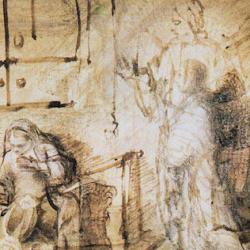Leviticus 18:23 describes male or female bestiality as tebel, a noun related to the verb balal, the word used to describe the confusion of languages at Babel. Tebel is often translated as “confusion.” That makes sense; bestiality crosses created boundaries between animals and human beings. It is a recognizably “confusion.”
The word is used in Leviticus 20:12, which deals with the penalty for lying with a daughter-in-law. That also is “confusion.” These are the only two uses of the word in the sexual legislation of Leviticus 18 and 20.
Why sex with a daughter-in-law is tebel is not so obvious. Are we to understand the lying with your daughter-in-law is somehow analogous to bestiality? How? Is it more like bestiality than other forms of incest? How? What makes incest with a daughter in law “confusion,” and sleeping with your mother, aunt or sister not confusion? How is uncovering the nakedness of a daughter-in-law confusion when male-male sex isn’t? The latter is described as to’evah (“abomination”; Leviticus 18:22; 20:13).
We can begin by noting that the terms used to assess different forms of sexual sin may not be exclusive. Bestiality is tebel and homosexual acts are to’evah, but at the end of Leviticus 18 to’evah covers all forms of prohibited sex: You “shall not do any of these abominations (to’evoth), neither the native nor the alien who sojourns among you” (18:26; cf. vv. 27. 29, 30). Even though maternal incest and homosexual acts aren’t explicitly described as tebel, the word may still apply.
The sexual laws of Leviticus presume an order of creation and an order of marriage. There is an order of creation because God made natural kinds, and set boundaries separating those kinds. Beasts are beasts and men are men, and they aren’t to form one flesh. Genesis 2, where Adam fails to find a partner among the animals, is the background. Similarly, God’s differentiation of man into male and female is the root of the prohibition of homosexual acts. God built Eve in a “sacrificial” procedure of division and reunion; homosexuality involves acts of decreation, as flood waters decreate by overwhelming the division of land and sea.
The language of the bestiality laws in both chapters 18 and 20 sheds further light. In 18:23, men are prohibited from “giving lying-with” to a beast, and women are prohibited from “standing before” a beast to “breed” with it. “Stand before” is priestly language (Deuteronomy 10:8). Similarly, in 20:16, the woman “approaches” (qarab) the animal, a verb that, in Leviticus, usually bears a liturgical connotation (Leviticus 1:1-3). “Approaching” a forbidden sexual partner is analogous to, if not identical with, sacrilege, a trespass on “holy ground.”
These liturgical/sexual analogies hint at the logic of these laws. Created kinds and differentiations manifest the difference between the Creator and creature, behind which is the Trinitarian difference of Father, Son and Spirit, the ultimate ground of differentiation in the created order. The tebel involved in bestiality is not only a confusion of natural kinds, but the ultimate confusion: Worshiping the creature rather than the Creator.
Cultural and social boundaries aren’t built into creation. A father has a biological relation with his son, but no biological relationship with his daughter-in-law. Considered as a natural being, the daughter-in-law is not off-limits. She’s likely younger than the man, but there is nothing in Torah that prohibits October marrying May. What makes the woman off-limits is the fact that there is a marriage bond between her husband, the man’s son, and herself. As an institution, marriage is from God; it’s a divine institution. Each specific marriage is also a creation of God: “What God has joined together, let no man separate.” But that divine act of creating a marriage is mediated through human action. A minister, not God Himself, declares “You are now husband and wife.” Trespassing this divine-human boundary is as much a confusion of kinds and categories as a man or woman lying with a beast.
Here again the analogy of liturgical and sexual life is evident. Marriage is a creative sacrificial movement, a separation (“leave and cleave”) that leads to a transfiguration (Adam becomes an ‘ish when he sees the ‘ishshah) and union (“one flesh”). By virtue of the marriage “sacrifice,” a man and woman share a single covering. The original sacrifice outside Eden culminated in “coverings” for Adam and Eve, which hid the shame of their nakedness. As man and wife, they were covered by a single covering. To “uncover nakedness” of anyone other than the one who shares the same sacrificial covering reverses the sacrificial movement of marriage. Uncovering nakedness exposes shame; it is an act of un-sacrifice. Though performed by human beings, marriage ceremonies create new kinds and categories. God Himself performs the sacrificial act of separation and union that makes a marriage, and he creates new categories for the persons involved. A woman becomes “daughter-in-law” as a man becomes “father-in-law.” And those kinds are not to be mixed.
The “confusion” involved in incest with a daughter-in-law is connected with violation of generational boundaries. Generational succession is natural, but these natural boundaries become relevant in Leviticus because of marriage. A man who takes his father’s wife confuses “son” and “husband” and perhaps aims to seize the father’s status (cf. Absalom with David’s concubines). A man who uncovers the nakedness of his daughter-in-law crosses a generational boundary in the other direction. He is potentially father and grandfather of his children. He doesn’t seize the authority of the old but the future of the young. He confuses generations as he lays claim to a future that is not his to claim. There is tebel in any cross-generational incest, but, to repeat, this is not simply a matter of age. What makes these sexual relations “confusion” is the social, divine-human institution of marriage.
Leviticus aims to “humanize” Israel, to deliver her from the bestial structures of paganism and from the undifferentiated sexuality of animals. And it’s a humanization that is highly relevant to our current sexual tebel. We need to be reminded that God regards both “natural” and certain “cultural” boundaries as inviolable. The “social” relationship of marriage is God’s own construction.











